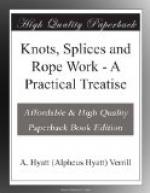CHAPTER II
SIMPLE KNOTS AND BENDS
For convenience in handling rope and learning the various knots, ties, and bends, we use the terms “standing part,” “bight,” and “end” (Fig. 3). The Standing Part is the principal portion or longest part of the rope; the Bight is the part curved or bent while working or handling; while the End is that part used in forming the knot or hitch. Before commencing work the loose ends or strands of a rope should be “whipped” or “seized” to prevent the rope from unravelling; and although an expert can readily tie almost any knot, make a splice, or in fact do pretty nearly anything with a loose-ended rope, yet it is a wise plan to invariably whip the end of every rope, cable, or hawser to be handled, while a marline-spike, fid, or pointed stick will also prove of great help in working rope.
[Illustration: Fig. 3.—Parts of rope.]
To whip or seize a rope-end, take a piece of twine or string and lay it on the rope an inch or two from the end, pass the twine several times around the rope, keeping the ends of the twine under the first few turns to hold it in place; then make a large loop with the free end of twine; bring it back to the rope and continue winding for three or four turns around both rope and end of twine; and then finish by drawing the loop tight by pulling on the free end (Fig. 4).
[Illustration: Fig. 4.—Whipping.]
All knots are begun by “loops” or rings commonly known to mariners as “Cuckolds’ Necks” (Fig. 5). These may be either overhand or underhand, and when a seizing or fastening of twine is placed around the two parts where they cross a useful rope ring known as a “clinch” is formed (Fig. 6). If the loose end of the rope is passed over the standing part and through the “cuckold’s-neck,” the simplest of all knots, known as the “Overhand Knot,” is made (Fig. 7). This drawn tight appears as in Fig. 8, and while so simple this knot is important, as it is frequently used in fastening the ends of yarns and strands in splicing, whipping, and seizing. The “Figure-Eight Knot” is almost as simple as the overhand and is plainly shown in Figs. 9 and 10. Only a step beyond the figure-eight and the overhand knots are the “Square” and “Reefing” knots (Figs. 11 and 12). The square knot is probably the most useful and widely used of any common knot and is the best all-around knot known. It is very strong, never slips or becomes jammed, and is readily untied. To make a square knot, take the ends of the rope and pass the left end over and under the right end, then the right over and under the left. If you once learn the simple formula of “Left over,” “Right over,” you will never make a mistake and form the despised “Granny,” a most useless, bothersome, and deceptive makeshift for any purpose (Fig. 13). The true “Reef Knot” is merely the square knot with the bight of the left




